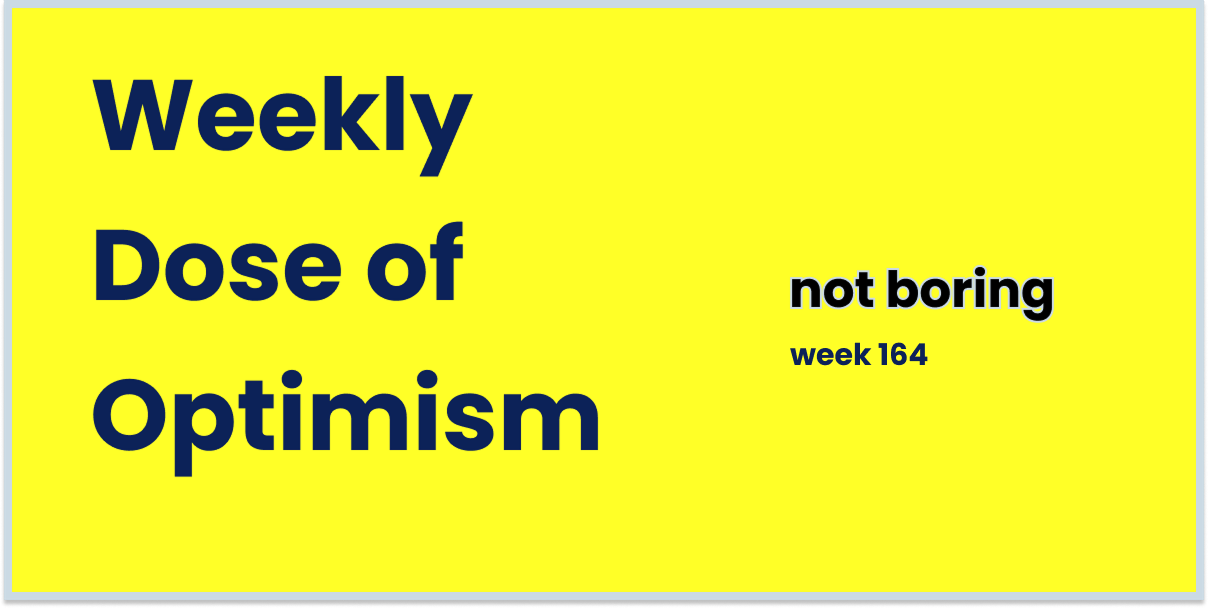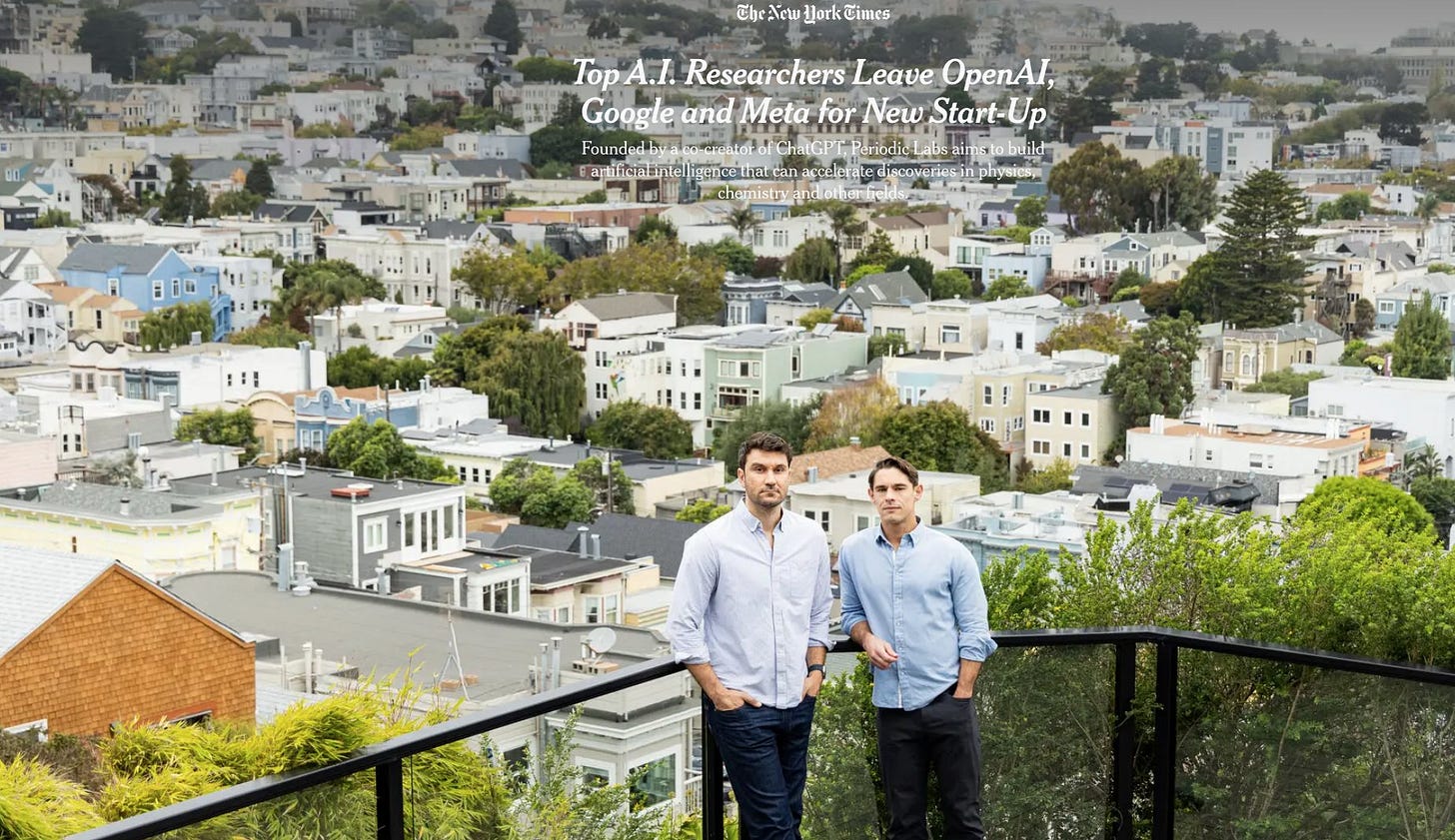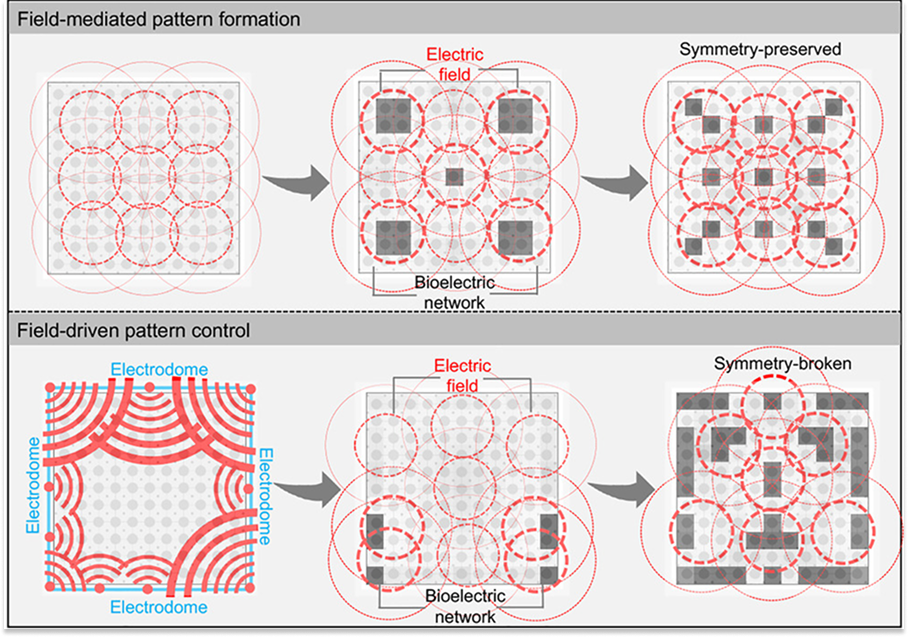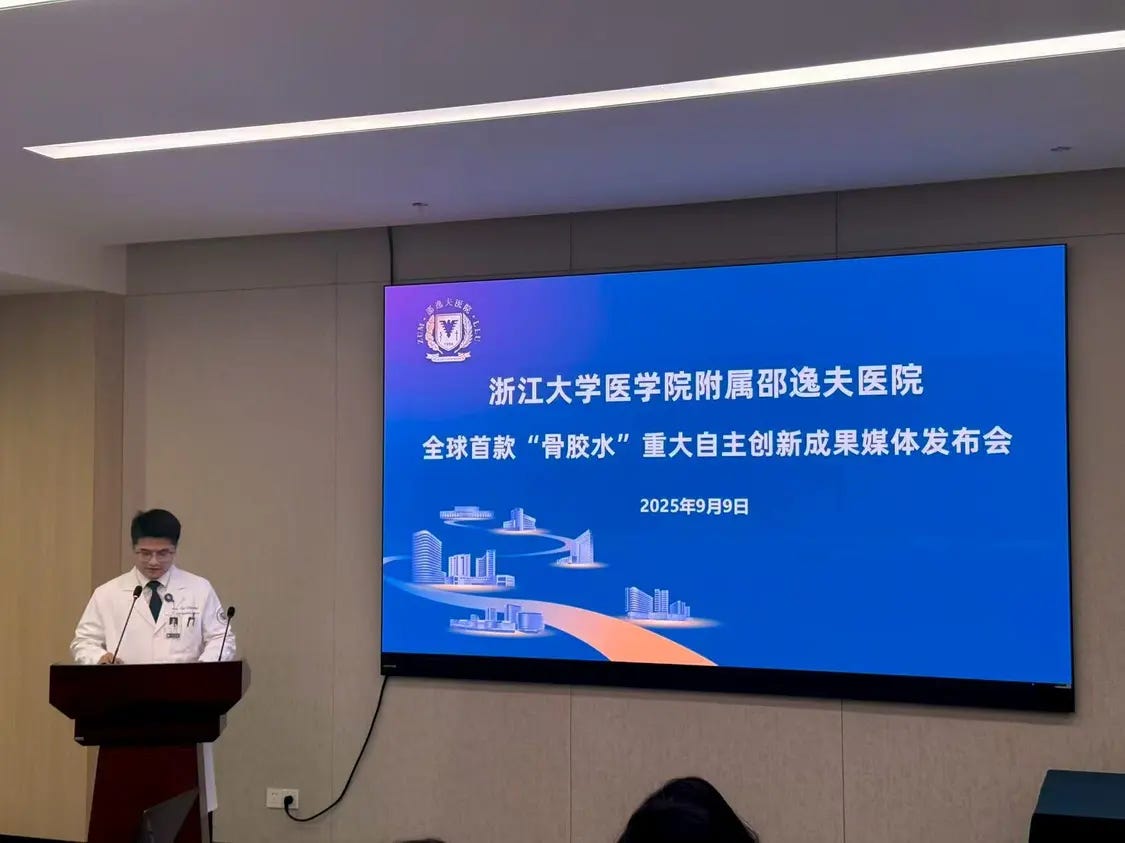Weekly Dose of Optimism #164
Planet, space deliveries, delivery robots, AI scientists, bioelectricity, and bone glue
Hi friends 👋,
Happy Friday, happy Fall in New York to those who celebrate, and welcome to our 164th Weekly Dose of Optimism.
Big, big week for the optimists. We’ve got optimistic sci-fi, space deliveries, delivery robots, AI scientists, bioelectricity, and bone glue.
We didn’t even have to talk about Sora 2, which does seem better than Vibes but does not meet this week’s high bar. A story on TrumpRx also landed on the cutting room floor; cheap drugs are great, but the grift was enough to drop it out of the Top 5. We did, however, sneak in an extra little story about super stem cells improving monkey longevity. What a world.
Let’s get to it.
Today’s Weekly Dose is brought to you by… WorkOS
Bots Abuse Free Trials. WorkOS Radar Stops Them.
Free trials help AI apps grow, but bots and fake accounts exploit them. They steal tokens, burn compute, and disrupt real users.
Cursor, the fast-growing AI code assistant, uses WorkOS Radar to detect and stop abuse in real time. With device fingerprinting and behavioral signals, Radar blocks fraud before it reaches your app.
(1) Jason Carman and StoryCo Release Planet
Packy here. Long time readers of the Dose will know that we are big Jason Carman fans. We’ve shared a ton of his S3 videos and collabs with the Abundance Institute on many of the most compelling startups in the physical world.
But Jason has been saying from the first time I spoke with him that the plan was to use those videos to learn, and that the real goal was to turn those learnings into realistic, optimistic sci-fi films. And by god, he pulled it off.
Last weekend, Jason and the Story team premiered their first sci-fi short film, Planet, in San Francisco and then dropped it on YouTube. I watched it this week and it’s shockingly good, and they apparently made it on a small budget. Patrick O’Shaughnessy tweeted, “I asked Jason what this cost him to make and could not believe the answer. Incredible visuals per $ spent.” I honestly don’t know how they did it. It’s crazy that someone I’ve hung out with can make something that looks like this.
The story is great too. Surprisingly beautiful. I won’t spoil it. It’s only 38 minutes and you should watch it this weekend.
Congrats Jason! Can’t wait for the next one (will rewatch this many times until then).
(2) Inversion Unveils Arc - A First of its Kind Space-Based Delivery Vehicle
From Inversion
Inversion, the aerospace and defense technology company building highly-maneuverable reentry spacecraft, today unveiled Arc, its flagship space-based delivery vehicle. Arc reshapes defense readiness by enabling access to anywhere on Earth in under an hour – allowing for the rapid delivery of mission-critical cargo and effects to austere, infrastructure-limited, or denied environments.
Meanwhile, startups are building real products that would fit perfectly in Jason’s film.
Inversion unveiled Arc, a spacecraft designed to deliver cargo from orbit to anywhere on Earth in under an hour. Basically like GoPuff for critical supplies.
Instead of waiting days for military logistics, you call a capsule down from low-Earth orbit, it screams through hypersonic reentry, and lands under parachutes with whatever you need. Arc also doubles as a reusable hypersonic testbed, giving the Pentagon a cheaper, faster way to study high-speed flight trajectories. We do love a good dual use business model like Inversion’s.
Like many of the moonshot companies using that business model, Inversion is starting by serving existing customer needs like dropping military supplies in far-flung places and helping with hypersonic testing. But if it can scale and bring down the costs of its delivery meaningfully, you can envision a world in which space becomes the most efficient delivery route for moving certain goods across the world.
While you wait for your space delivery, DoorDash rolled out a cute little food-delivering robot named Dot.
(3) Top A.I. Researchers Leave OpenAI, Google, and Meta for New Start-Up
Cade Metz for The New York Times
But Mr. Fedus and Dr. Cubuk believe that no matter how many textbooks and academic papers these systems analyze, they cannot master the art of scientific discovery. To reach that, they say, A.I. technologies must also learn from physical experiments in the real world.
Periodic Labs has $300 million and some of the people behind ChatGPT, DeepMind’s GNoME, the neural attention mechanism, and MatterGen to create an AI scientist.
The plan is to combine models with autonomous science labs, where bots can carry out experiments that both test their hypotheses and generate tons of new data:
Autonomous labs are central to our strategy. They provide huge amounts of high-quality data (each experiment can produce GBs of data!) that exists nowhere else. They generate valuable negative results which are seldom published. But most importantly, they give our AI scientists the tools to act.
They’re starting with physical sciences where results are verifiable, the closest physical-world equivalent to something like coding, which has been the most successful AI use case outside of chat so far. It’s where they can most easily apply the scientific process.
It’s also where they might be able to produce some sci-fi results pretty early. The company says it’s targeting superconductors that work at higher temperatures (remember the high-temperature superconductor rollercoaster last year?) but plan to attack a much wider variety of materials and uses over time.
Periodic is not quite as addictive as feeds full of slop videos, but it seems pretty cool!
This seems to be an idea whose time has come. This week, researchers at MIT announced CRESt, is an AI–robotics platform built to accelerate materials discovery.
CRESt pulls from scientific papers, chemical recipes, imaging, and human feedback. Robots handle the lab work (mixing, testing, analyzing) while the system processes results, forms hypotheses, and suggests the next step. Scientists can talk to it in plain English, and CRESt flags errors mid-experiment with cameras and vision models. Think of it as an army of little MIT lab assistants, but faster and tireless.
In a three-month trial, CRESt ran 3,500 experiments across 900 chemistries and discovered a fuel cell catalyst that reduced reliance on expensive palladium while hitting record power density. That’s notable because rare metals remain a big bottleneck in fuel-cell economics.
One discovery is proof of concept. The real importance is scale: if CRESt can run hundreds of thousands of experiments, stacking insights along the way, the pace of progress might really begin to accelerate.
May the best AI scientists win.
(4) Field-mediated bioelectric basis of morphogenetic prepatterning
Santosh Manicka & Michael Levin in Cell Reports Physical Science
These results highlight the potential of the electric field both as a facilitator of collective patterning and as a macroscale interventional target for applications in regenerative medicine and bioengineering.
Don’t count the human scientists out just yet!
This week, Michael Levin (who you might remember from last week’s Dose) and Santosh Manicka released a paper showing that bioelectric fields (invisible, tissue-wide electrical patterns) play a direct role in how living things develop their shapes (morphogenesis).
Scientists have traditionally focused on genes, proteins, and chemicals as the main drivers of how living things develop. DNA is the blueprint of life, etc… Levin has been arguing that bioelectricity is way more important than it’s gotten credit for, and in this paper, he and Manicka argue that electric fields themselves can act as a kind of “control knob” for shaping biological form.
This is incredibly cool science. It suggests a new, potentially more powerful way to influence development and regeneration: instead of micromanaging every gene or cell, you could steer the whole system by tweaking its bioelectric field. This approach could open up new strategies for regenerative medicine, birth defect repair, and even synthetic biology. Imagine “sculpting” tissues or organs by applying the right electrical signals.
Beyond making the argument, Levin and Manicka built computational models showing that adding an electric field to a network of cells makes it much better at forming complex patterns. They show that you can “seed” a pattern (like a face) by briefly stimulating just the boundary of a tissue, and the field will help the rest self-organize. Strikingly, their model’s behavior matches real developmental patterns seen in frog embryos! It seems like there’s a there there.
If we’re entering the Electric Era, there’s something beautiful about the idea that the biggest breakthroughs in biology might come from applying electricity, too.
(5) Chinese Doctors Develop Bone 02 Bone Glue
via Arnaud Bertrand on Twitter
It’s inspired by oysters because the researchers noticed their extraordinary ability to firmly attach themselves in harsh underwater environment by secreting a special adhesive known as bio-cement, which creates a strong chemical interaction with surfaces and hardens quickly.
A couple of weeks ago, a team of orthopedic surgeons in Zhejiang province who formed a company called 源囊生物 (Yuannang Bio) released a product called Bone 02. Forgive us for missing it; the release was in Mandarin. This week, Arnaud Bertrand summarized the news in English.
Basically, Bone 02 is glue for bones modeled after oysters’ bio-cement. We’ll just quote Arnaud on what the stuff does:
The properties of the glue are almost miraculous (sources: http://news.cn/20250910/1df9380a9ed945dca7142431f530a0c8/c.html and https://news.ifeng.com/c/8mVMq4PBdmJ):
- Nearly instant adhesion in blood-soaked wet physiological environments (it just takes 2-3 minutes)
- Extremely strong adhesive properties (bonding tensile force of over 400 pounds - over 181 kg)
- Complete biodegradability that naturally absorbs after about 6 months as the bone heals (no need for secondary surgery previously required in conventional treatments)
- Vast reduction of infection risks related to the traditional metal plates and screws normally needed for bone surgery
- Minimally invasive and rapid surgery since you just need a small opening large enough to apply the glue (as opposed to a complex surgery attaching metal fixations)
This glue could be especially useful for fractures with small bone fragments which are very difficult to fix with metal plates and screws.
Bone 02 has undergone trials - it “achieved seamless bonding of all fracture fragments” - the results of which will soon be published in a peer-reviewed paper.
Separately, Chinese scientists announced that super stem cells reversed signs of aging in monkeys. Improved memory, protection against neurodegeneration, bone loss prevention, tissue rejuvenation, and a reduction in inflammation and senescent cells (cells that accumulate to promote aging). Oo oo ah ah. Big month for Chinese scientists!
If we don’t get access to the bone glue and life extension because of a trade war, we’re going to have a bone to pick with someone.
Bonus: Thatch
ICYMI, we published a Deep Dive on Thatch on Wednesday. For as many people as possible to access the breakthroughs we write about here every week, we need to rewire the incentives in the US healthcare system. Thatch is doing it.
Have a great weekend y’all.
Thanks to WorkOS for sponsoring. Fight the bots and fakes.
We’ll be back in your inbox next week
Thanks for reading,
Packy + Dan







Wow! (on the bone glue). Go China! (at least until the war starts...)
Is it ok to feel both stupid and informed in the same post?
:-)